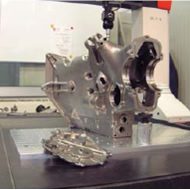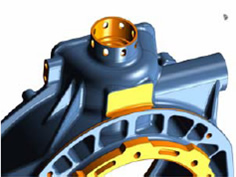Tough Casts
CRP pioneers titanium rapid casting methods to meet motorsports needs.
Latest News
November 8, 2007
By Sara Ferris
 Figure 1. Titanium gearbox developed for Minardi. |
Rapid casting combines rapid prototyping, which is used to manufacture a disposable pattern, and investment casting technology. The pattern is made using SLS (selective laser sintering) prototyping systems. The pattern then undergoes wax infiltration via immersion and capillarity to increase its strength. It’s then immersed in a ceramic bath. The lost pattern is removed via dewaxing with flash firing or in an autoclave. The ceramic shell is subsequently sintered, and the alloy is cast with inductor or voltaic arc.
Rapid casting with laser-sintered patterns allows complete freedom in shape conception. This reduces undercut and toolpath problems during CNC machining. The end result is a reproduction of the RP patter with tolerances and surface finishes of a quality comparable to fully machined parts.
Italian company CRP, in conjunction with DTM, developed the CastForm material frequently used for rapid casting patterns. CastForm reduces the amount of ash produced when the ceramic shell is flushed. To meet the needs of CRP’s Formula One racing customers, the two companies set out to develop a new material for use in titanium alloy casting.
CRP uses the Ti-6Al6V alloy, which contains 6% aluminum and 4% vanadium to provide an excellent combination of stress resistance and toughness, with optimal wear resistance.
 Figure 2. Model of racing wheel upright for rally raid car. |
Titanium casting has high reactivity, so chemical milling is required to remove the alpha case created when the metal touches the ceramic shell. HIP (hot isostatic pressure) applied in an inert atmosphere (argon) is also needed to eliminate micro-porosity and shortage of material inside the casting. TIG weld repair in an inert atmosphere can also be used to fill in porosity or HIP hollows. Controlled shot peening reduces stress and increases fatigue resistance.
CRP’s first titanium parts were front and read uprights made for Formula One team Minardi. The upright is the connecting part of the wheel where the hub transmits the engine rotational power to the tires. The suspension brackets, the front steering bracket, the rear convergence tie-rod and the brake calipers are connected to the uprights.
The main properties required in the uprights were lightness, stiffness, and reliability. Uprights were generally manufactured in a process that involved forming and cutting steel sheets. Welding, heat treatment, CNC machining, and painting were also involved. Using this process, engineers weren’t able to optimize the uprights, so they were heavier than they should have been. Because the uprights were welded, their life expectancy was shortened.
CRP also developed a titanium gearbox for Minardi. The requirements were similar to those of the uprights, but the complexity and size of the piece were greater. By using titanium, CRP reduced the weight of the gearbox by 25% from a magnesium one.
 Figure 3. Racing wheel upright after redesign to cut weight. |
More recently, CRP made a racing wheel upright for the 2007 Mitsubishi Pajero/Montero Evolutions Rally Raid car. That upright holds the wheel hub bearing and is formed with various mountings and brackets for suspension attachment (wishbones and damper) and various analysis sensors.
CRP is reworking the design to get uniform wall thickness all around to improve casting quality and save weight. A new distribution of the ribs will provide better response to the mechanical requirements caused by stress.
The cap-type structure is a direct response to structural calculation made on the model. This new morphology results in more uniform stress distribution and obvious weight savings.
Sources: Press materials received from the company and additional information gleaned from the company’s website.
Subscribe to our FREE magazine, FREE email newsletters or both!
Latest News
About the Author
DE’s editors contribute news and new product announcements to Digital Engineering.
Press releases may be sent to them via [email protected].






